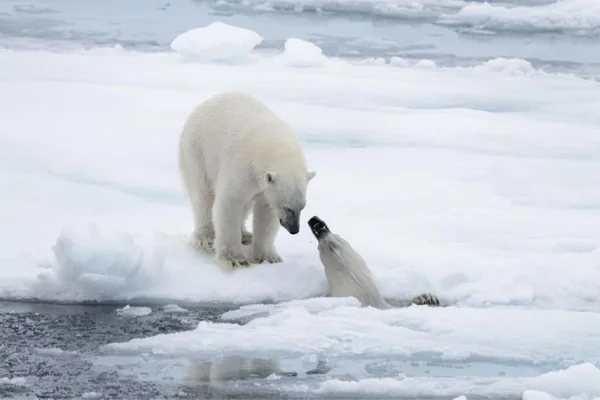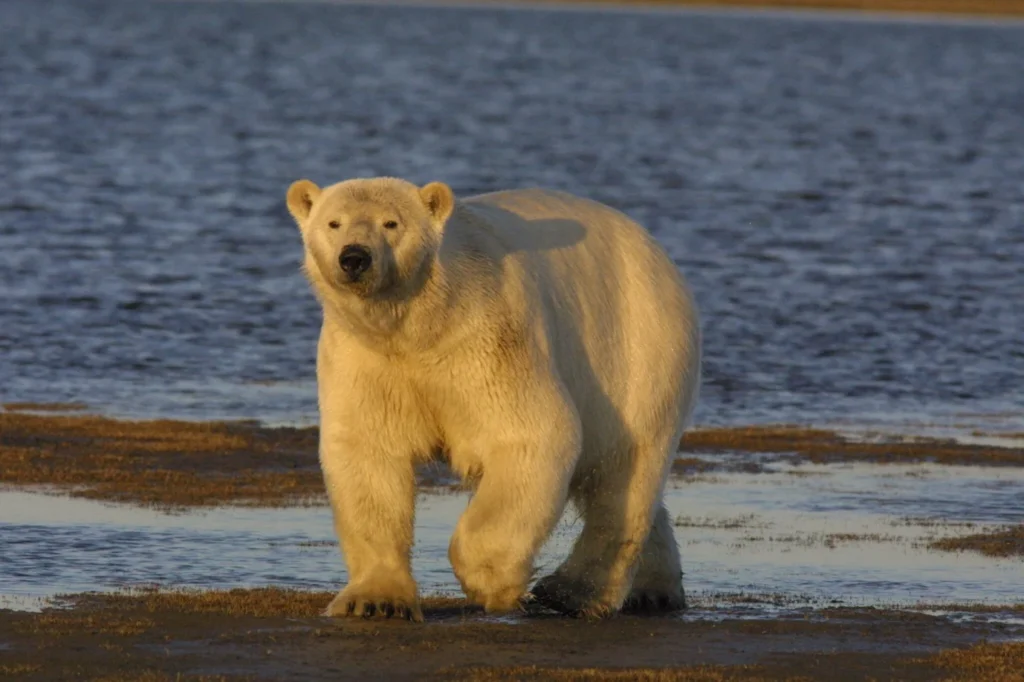A polar bear’s death in Alaska’s northernmost community, Utqiagvik, has been reported due to avian flu.
About Polar Bear:
- Polar bears are the largest carnivorous land mammals, with adult males weighing over 1,700 pounds and females about half that size.
- Newborn polar bears weigh approximately 1.5 pounds, showcasing significant growth throughout their life.
- The species is distinguished by several physical adaptations, including hollow fur for camouflage and a thick layer of body fat for insulation.
Physical and Behavioral Adaptations
- The white fur, which is hollow, reflects light and camouflages the bear in its icy environment.
- Polar bears have black skin underneath their fur, evident on their noses, to absorb heat.
- Their footpads have a “non-slip” surface, aiding movement on slippery ice, and webbed feet to assist in swimming.
- Unlike other bears, polar bears are considered marine mammals due to their dependence on the marine environment for food and habitat.
Habitat and Range
- Primarily found north of the Arctic Circle, extending to the North Pole, with some populations south in Hudson Bay, Canada.
- Dependent on sea ice for hunting seals, their primary food source, and live in regions like Alaska, Canada, Russia, Greenland, and some northern islands owned by Norway.
Diet and Hunting
- Almost exclusively carnivorous, primarily feeding on ringed and bearded seals by waiting for them to surface on sea ice.
- The diet is critical for maintaining their large body mass and involves strategic hunting techniques to capture seals, walruses, and occasionally whale carcasses.
Behavioural Traits
- Polar bears are solitary creatures except during mating, raising cubs, or when attracted to a food source.
- Known for their long fasting periods, especially pregnant females, who fast while denning to give birth and raise cubs.
Life Cycle and Reproduction
- Breeding occurs in late spring, followed by delayed implantation, allowing females to assess their health before gestation.
- Cubs are born during winter in dens and are entirely dependent on their mother for nourishment and protection.
- Female polar bears undergo prolonged fasting before and during denning, making them vulnerable to environmental changes that affect food availability.
Conservation Status:
- IUCN Red List: Vulnerable
About Highly Pathogenic Avian Influenza (HPAI):
- HPAI is a viral infection caused by certain subtypes of avian influenza A viruses, leading to severe disease and high mortality rates in poultry.
- Virus Classification: Among the avian influenza A viruses, only some A(H5) and A(H7) viruses are classified as HPAI A viruses, with most being low pathogenicity avian influenza (LPAI) A viruses.
Impact on Poultry:
- HPAI A(H5) or A(H7) can cause up to 90% to 100% mortality in chickens, often within 48 hours of infection.
- Symptom Variation: While chickens exhibit high mortality rates, ducks may carry the virus without showing any signs of illness.
Transmission and Spread:
- Spillover to Wild Birds: HPAI can spread back to wild bird populations, leading to further geographic dispersal as these birds migrate.
- Species Variation in Symptoms: Some wild bird species can carry HPAI A(H5) or A(H7) without apparent sickness, while others may be severely affected.
Location of Arctic:
- The Arctic is a polar region located at the northernmost part of Earth.
- It consists of the Arctic Ocean and parts of Canada, Russia, Greenland (a territory of Denmark), the United States (Alaska), Norway, Sweden, Finland, and Iceland.
- The Arctic Circle, which is an imaginary line circling the Earth at approximately 66.5 degrees north latitude, is often used to define the southern boundary of the Arctic region.
- It is known for its extremely cold temperatures, ice-covered seas, and unique ecosystems.
- It is of great environmental significance, and its changes, such as melting sea ice and permafrost, have global implications for climate and sea level rise.
- It is also home to indigenous peoples who have adapted to the challenging conditions of the region for generations.
Ref: Source
| UPSC IAS Preparation Resources | |
| Current Affairs Analysis | Topperspedia |
| GS Shots | Simply Explained |
| Daily Flash Cards | Daily Quiz |





